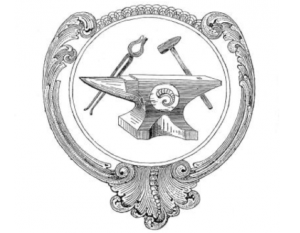Repoussé IV “Drills and Drilling”
Note:This is a continuation of notes compiled by the late repoussé artisan, Nahum Hersom. The text is printed verbatim, unless indicated by parenthesis and /or initials “D.N.”. The processes listed here are not necessarily endorsed by me, or Bighorn Forge, Inc. They are being published so that the writings of Nahum Hersom might be preserved and shared with aspiring artisans, blacksmiths, metal workers, and others. Always wear safety glasses and other protection when working with tools.
Drills and Drilling
For drilling holes, grind drill points flatter and relieve heel behind cutting edge. Also grind chisel point relief to start cut on a center punch mark. Do this on (the) corner of (a) grindstone that has a good square corner.
To drill a hole slightly oversized, grind the point of drill (bit) off center, and drill a small pilot hole for it to follow, which is the size of (the) chisel point of (the) drill (bit).
Ball drill (bit) points are ground to a ball shaped template; also grind a chisel point on (the) tip and be sure (the) heels are ground back enough to clear (the) metal so heels of drill (bit) point don’t drag.
To drill a true size hole, grind the outer corner of drill (bit) lip off (the) back, about 3/32″. Drill a pilot hole, then (use) a number or alphabet smaller drill (bit) than (the) hole (diameter) wanted. Then use prepared drill (bit) and feed drill slowly using cutting oil.
To drill (through) thin sheet-metal and plastic sheet, use a spur or “brad point” ground drill (bit). Nowadays, these “brad points” are used mostly for wood work; however, they are available in “High Speed Steel” for drilling metal (see supplier.)
After drilling a hole, cut (the) bottom burr off with a drill bit mounted in a wood file handle. Grind (the) point like (an) ordinary drill bit. Use spur drill (bits) when drilling clear plastic sheet (will not break out plastic as does regular point as it goes through sheet) as spur drill (bits) cut outer edge through sheet, (and) do not catch on (the) bottom of (the) hole.
To drill holes in paper, rubber, leather, etc., a hollow bit called a “rubber drill” is used which has 1/4 of (the) tube end removed-leadingedge sharpened as well as bottom- sharpened on (the) inside. This produces a clean hole. These are made on a metal lathe-hole drilled in the same end of round H.S. steel or drill rod to (the) depth needed. The resultant wall left is only about .015 thick-filed to shape and heat treated (tempered -D.N.) to blue color.
Water will help lubricate drilling holes in rubber, especially deep holes.
To drill flat bottom holes, square off drill to a straight edge, relieve heels for clearance by a few degrees- drill hole with regular drill bit to approximate depth needed- then use (the) flat end drill (bit) to square bottom.
(End of this installment)
I will continue to publish Nahum Hersom’s writings as time allows.
…Dan Nauman
“It is very strange that the years teach us patience-that the shorter our time, the greater our capacity for waiting.”…Elizabeth Taylor.

No comment to “Repoussé IV “Drills and Drilling””
Ted Throckmorton - January 3, 2012
Dan;
I find that it is awsome that you would take on this project and pass it on as you are doing.
I lack the proper words to say how much I appreaceate that you would include me on your mailing list.
Grandpa was a great artist, friend, and mentor.
You have become that also. We need more men in this world like you and Grandpa!
I am getting long in the tooth, my body is worn out, but my desire is as bright as it has ever been. In fact my appreaction factor has grown 1000 times to the 10th power as I have gotten older.
So when I say “THANK YOU” – Please know that I mean it!
Please keep up and honor what ever it is that is driving you, it is correct!
Ted Throckmorton
bighornforge - January 3, 2012
Ted,
Publishing Grandpa’s writings are the least I can do, as I owe much to him for passing on his knowledge and passion to me. Glad to know you too, appreciate Nahum.
…Dan